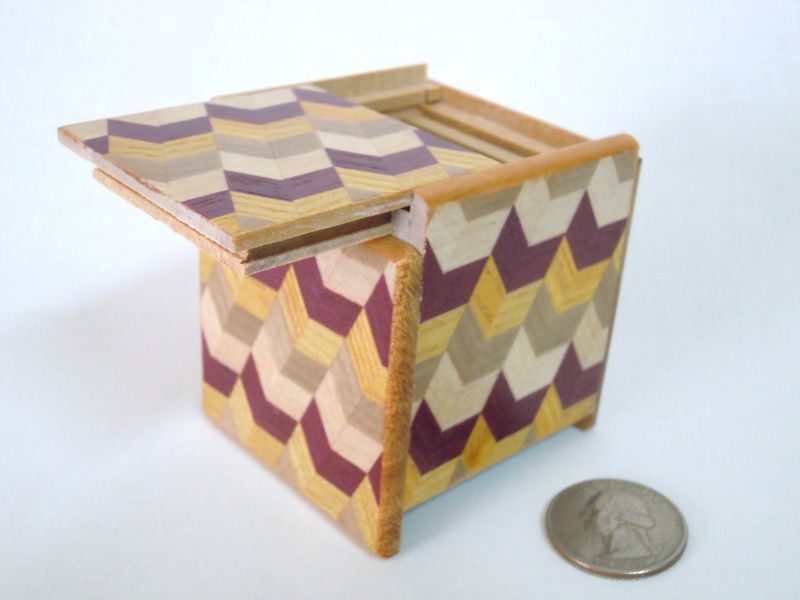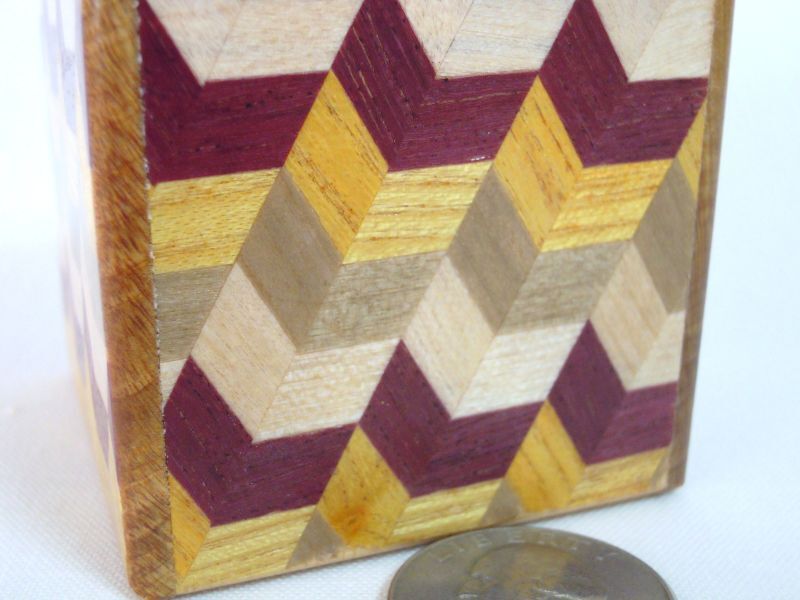Unique yosegi
The hot days continue, but I feel like the summer sunlight has changed a bit. The intense heat we had last week has eased, and now I sense a milder warmth with the occasional breeze. This might be a sign that autumn is approaching. In my area, we sometimes get brief but heavy rain in the evening, which helps cool down the temperature and makes it more comfortable.
I'd like to introduce one of my past works. This is a 2-sun cube-type Japanese puzzle box. From the photos, it appears to be a simple 4-step mechanism. It was made in 2010. The size is the same as the 2-sun cube boxes I still make today. Despite the simplicity of the 4-step mechanism, first-timers often find it surprisingly challenging to open. Since all the sides and edges of this box are the same length and it doesn't have a sliding key, it’s hard to tell which side will move first. In this sense, I’ve also heard that the 4-step 2-sun cube boxes with a hidden drawer can sometimes be tricky, as it’s not easy to find the first moving panel.
The yosegi design used on this box is also unique. It's a pattern known as "Yabane". it's one of traditional yosegi-zaiku. I created this one. The design is made by cutting striped wood at an intentional angle—around 30 degrees, I believe. These angled pieces are then aligned to form an arrow-like pattern. By arranging these patterns side by side, a larger design emerges. This design is sliced into thin sheets and applied to the puzzle box as a board. Looking at the photos, I notice that Purpleheart wood is prominently used, and I'm a bit surprised at how well I managed to slice it back then! 😂 Purpleheart wood is as hard as stone, making it quite challenging to slice such a large piece. A very sharp blade is necessary to work with this wood.
I have also created several other unique designs like this one, and I hope to make them again!
I'd like to introduce one of my past works. This is a 2-sun cube-type Japanese puzzle box. From the photos, it appears to be a simple 4-step mechanism. It was made in 2010. The size is the same as the 2-sun cube boxes I still make today. Despite the simplicity of the 4-step mechanism, first-timers often find it surprisingly challenging to open. Since all the sides and edges of this box are the same length and it doesn't have a sliding key, it’s hard to tell which side will move first. In this sense, I’ve also heard that the 4-step 2-sun cube boxes with a hidden drawer can sometimes be tricky, as it’s not easy to find the first moving panel.
The yosegi design used on this box is also unique. It's a pattern known as "Yabane". it's one of traditional yosegi-zaiku. I created this one. The design is made by cutting striped wood at an intentional angle—around 30 degrees, I believe. These angled pieces are then aligned to form an arrow-like pattern. By arranging these patterns side by side, a larger design emerges. This design is sliced into thin sheets and applied to the puzzle box as a board. Looking at the photos, I notice that Purpleheart wood is prominently used, and I'm a bit surprised at how well I managed to slice it back then! 😂 Purpleheart wood is as hard as stone, making it quite challenging to slice such a large piece. A very sharp blade is necessary to work with this wood.
I have also created several other unique designs like this one, and I hope to make them again!

